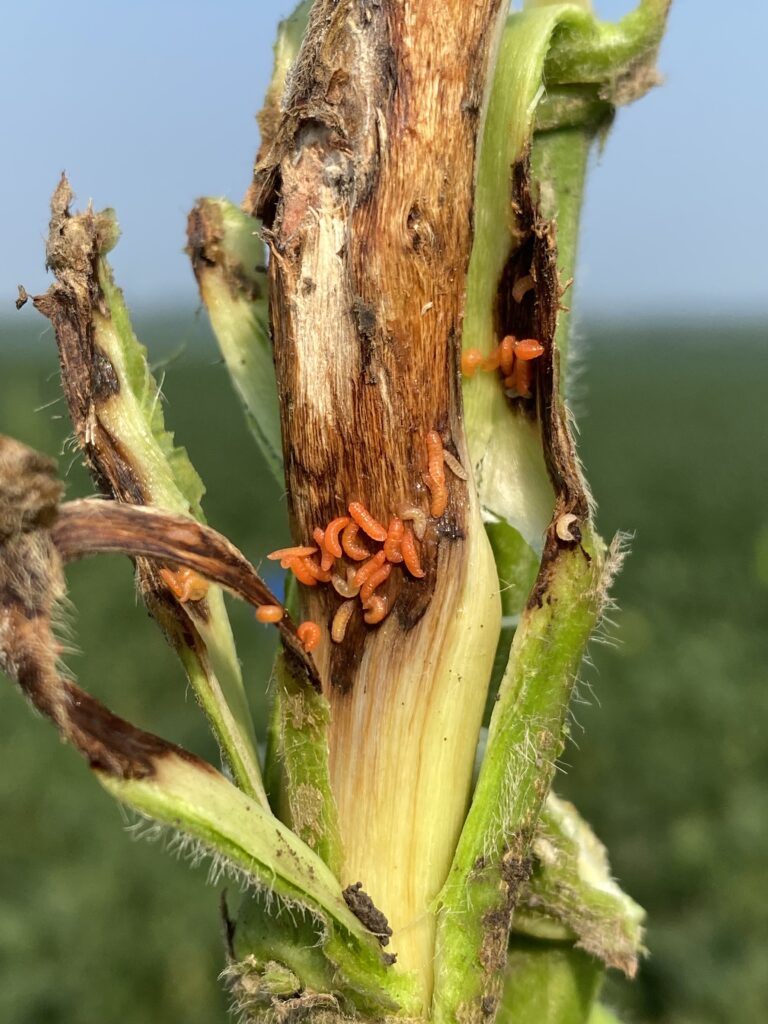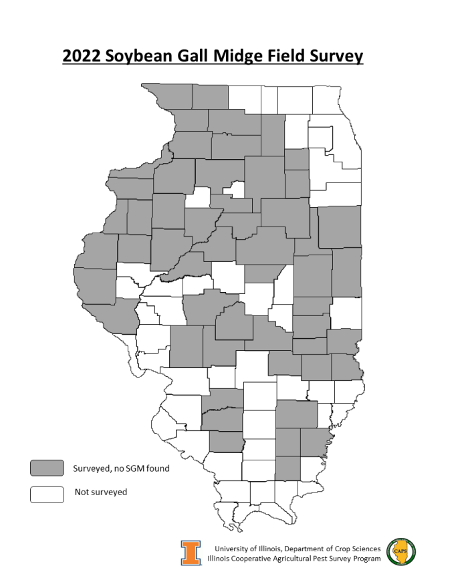N.J. Seiter and K. A. Estes

(Photo -Justin McMechan, Ph.D., D.P.H. University of Nebraska-Lincoln)
Soybean gall midge is a potential invasive species that has caused severe damage to soybeans in isolated areas, especially in eastern Nebraska and western Iowa. Unlike invasive pests such as the soybean aphid, brown marmorated stink bug, and spotted lanternfly, soybean gall midge is new to science – it isn’t known if it arrived here from another continent or simply emerged as a pest in recent years because there is no record of its existence prior to it being found as a soybean pest in Nebraska.
The 2022 soybean gall midge survey was headed by Dr. Nick Seiter and Kelly Estes of the University of Illinois. The objective was to inspect soybean fields throughout Illinois to facilitate early detection of the soybean gall midge, Resseliella maxima, a new pest of soybean that has not been found in Illinois.
The survey efforts were conducted in two phases. The majority of fields (302) were examined for soybean gall midge and sampled as part of the Illinois Statewide Insect Survey. Plants were assessed along the edge of every soybean field every 60-100 feet for signs of soybean gall midge infestation (dead/wilting plants and discolored stems). An additional survey of 36 fields in 9 counties (Hancock, Henderson, Mercer, Rock Island, Henry, Whiteside, Carroll, Stephenson, and Jo Daviess) was conducted along the northwestern border of Illinois with Missouri, Iowa, and Wisconsin. Fields were selected approximately every 5-10 miles in a transect along the state border that had rotation patterns that placed them at elevated risk of soybean gall midge infestation (adjacent soybean fields and dense uncultivated vegetation in near proximity).

Fields in this survey were examined for signs of gall midge infestation for a timed period of 5 minutes per field along the field edge adjacent to soybean grown the previous year (the most likely location to observe initial soybean gall midge activity). The epidermis of the stem was removed from areas showing potential signs of infestation to look for larvae. No soybean gall midge larvae were found during either survey. Soybean gall midge surveys will be repeated during Summer 2023.
After 338 soybean fields in 53 counties were inspected, there was no evidence of soybean gall midge found in Illinois.
“We did not find soybean gall midge during our survey efforts in 2022; this is encouraging, as this potential invasive species has been a serious issue in the Western Corn Belt,” says Seiter.
Fortunately, its rate of spread seems to be very slow, and it’s unknown if it will ever make it to Illinois and affect soybean production in our state. Regardless, this monitoring effort is critical for early detection if it does eventually arrive here. Its damage is unlikely to go unnoticed for very long if it does arrive In Illinois.
Nick and Kelly would like to thank Dr. Justin McMechan (University of Nebraska) for coordinating survey efforts and developing the monitoring protocol that was used.
Funding for this survey was provided by the Illinois Soybean Association and the North Central Soybean Research Program. For continuously updated information on where soybean gall midge has been found in the U.S. and how to manage it, visit Soybean Gall Midge Alert Network.


 and then
and then